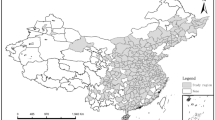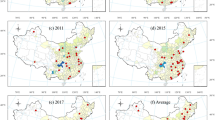Abstract
This study attempts to investigate the effect of the establishment of National New District (NND) on economic development and air pollution in China. For this purpose, this study adopts the difference-in-differences (DID) model, the propensity-score-matched difference-in-differences (PSM-DID) model, and the spatial difference-in-differences (SDID) model, using a panel data set of 69 large and medium-sized cities during the period of 2003–2018. The results show that NND promotes economic development but fails to reduce the emission of air pollution including per capita SO2 and per capita smoke without the consideration of spatial spillover effect. However, the promotion effect of NND on economic development is not supported after PSM matching. On the other hand, the advantage of the SDID model in policy evaluation is proved. For instance, with the consideration of spatial spillover effect, the win-win of promoting economic development and reducing air pollution are partially supported. Based on the above empirical findings, several policy implementations and research prospects are outlined.


Similar content being viewed by others
Data availability
The data used to support the findings of this study are available from the corresponding author upon request.
References
Barry N (2011) China’s economic policy today: the new state activism. Eurasian Geogr. Econ. 52(3):313–329
Chagas ALS, Azzoni CR, Almeida AN (2016) A spatial difference-in-differences analysis of the impact of sugarcane production on respiratory diseases. Reg Sci Urban Econ 59:24–36
Chao H, Lin GCS (2020) Spatializing the project of state rescaling in post-reform China: emerging geography of National New Areas. Habitat Int 91:102121
Feng YC, Wang XH, Du WC, Wu HY, Wang JT (2019) Effects of environmental regulation and FDI on urban innovation in China: a spatial Durbin econometric analysis. J Clean Prod 235:210–224
Hao M, Wang DH, Deng C, He ZW, Zhang JL, Xue DJ, Ling XM (2019) 3D geological modeling and visualization of above-ground and underground integration ——taking the Unicorn Island in Tianfu new area as an example. Earth Sci Inf 12(4):465–474
Lee MJ, Sawada Y (2020) Review on difference in differences. Korean Econ Rev 36(1):135–173
Li G, Yuan Y, Zhang MH, Zhao X, Ji L (2019) Key technical contents of the China VI emission standards for diesel fuelled heavy-duty vehicles new stringent emissions legislation aims to ‘win the blue sky defence war’ in China. Johnson Matthey Tech 63(1):21–30
Liang Z, Chao Y (2018) Disorder or reorder? The spatial production of state-level new areas in China. Sustainability 10:3628
Liu ZX (2010) Research on administrative management mode: “One City, Two Systems” in new special economic zone of China-Take Shanghai Pudong new district as example. Proceedings of Shanghai Conference on Management of Technology (Mot 2010):104–106
Liu ZW, De Jong M, Li F, Brand N, Hertogh M, Dong L (2020) Towards developing a new model for inclusive cities in China—the case of Xiong’an New Area. Sustainability 12(15):6195
Miao CL, Meng XN, Duan MM, Wu XY (2020) Energy consumption, environmental pollution, and technological innovation efficiency: taking industrial enterprises in China as empirical analysis object. Environ Sci Pollut R 27(27):34147–34157
Tang RZ (2014) Western film-reduced tourism product development based on the theory of new industrial district: Taking Chongqing Liangjiang International Film Studio as an example. Strategy in Emerging Markets, Management, Finance and Sustainable Development, pp 811–815
Tian YY, Jiang GH, Zhou DY, Ding KS, Su S, Zhou T, Chen DB (2019) Regional industrial transfer in the Jingjinji urban agglomeration, China: an analysis based on a new “transferring area-undertaking area-dynamic process” model. J Clean Prod 235:751–766
Wang QH (2017) The management of foreign private equity funds involves foreign investment and foreign exchange in the China (Shanghai) Pilot Free Trade Zone. Chin Econ 50(4):249–258
Wang L, Chao H, Li GC (2019) Diversification and local embeddedness: the rescaling of National New Area governance in post-reform China. Sustainability 11(22):6216
Wang YJ, Song LC, Han ZY, Liao YM, Xu HM, Zhai JQ, Zhu R (2020) Climate-related risks in the construction of Xiongan New Area. China Theor Appl Climatol 141(3-4):1301–1311
Wen B (2020) Old problems and new dilemmas: the conundrum of environmental management reform in China. J Environ Policy Plan 22(2):281–299
Wu X, Hu J, Li Y (2020) Multiscalar institutional complicity: an entrepreneurial city in China’s National New Area. China. 18(2):120–142
Xu Z, Chen Z, Lu M (2010) The core-periphery model of urban system in China (in Chinese). The J World Econ 7:144–160
Xu Z, Zhang ZF, Li C (2019) Exploring urban green spaces in China: spatial patterns, driving factors and policy implications. Land Use Policy 89:104249
Xu F, Wang ZQ, Chi GQ, Zhang ZX (2020) The impacts of population and agglomeration development on land use intensity: new evidence behind urbanization in China. Land Use Policy 95:104639
Yang J, Li Y, Hay I, Huang XJ (2019) Decoding national new area development in China: toward new land development and politics. Cities 87:114–120
Ye B, Zhou M, Yan D, Li Y (2020) Multi-objective decision-making for hybrid renewable energy systems for cities: a case study of Xiongan New District in China. Energies 13(23):6223
You L, Li YP, Huang GH, Zhang JL (2014) Modeling regional ecosystem development under uncertainty - a case study for New Binhai District of Tianjin. Ecol Model 288:127–142
Zang JN, Wan L, Li ZJ, Wang CY, Wang SY (2020) Does emission trading scheme have spillover effect on industrial structure upgrading? Evidence from the EU based on a PSM-DID approach. Environ Sci Pollut R 27(11):12345–12357
Zhang K, Cai GQ (2014) Construction strategy on low-carbon transportation system in New District of Lanzhou. Appl Mech Mater 505-506:537–541
Funding
Especially, we would like to thank the experts who participated in the improvement of this paper. Any remaining errors are the responsibility of the authors.
Author information
Authors and Affiliations
Contributions
YF: Conceptualization, methodology, and writing–original draft; XW: Writing—reviewing and editing.
Corresponding author
Ethics declarations
Ethics approval and consent to participate
Not applicable.
Consent for publication
Not applicable.
Conflict of interest
The authors declare no competing interests.
Additional information
Responsible Editor: Philipp Gariguess
Publisher’s note
Springer Nature remains neutral with regard to jurisdictional claims in published maps and institutional affiliations.
Rights and permissions
About this article
Cite this article
Feng, Y., Wang, X. Effects of National New District on economic development and air pollution in China: empirical evidence from 69 large and medium-sized cities. Environ Sci Pollut Res 28, 38594–38603 (2021). https://doi.org/10.1007/s11356-021-13494-5
Received:
Accepted:
Published:
Issue Date:
DOI: https://doi.org/10.1007/s11356-021-13494-5




